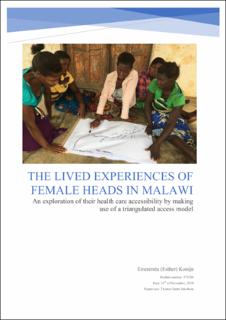| dc.description.abstract | Ensuring that everyone has good accessibility to health services remains a challenge, especially in developing country contexts, even though the concept of health care accessibility has been extensively investigated in the existing health geography literature. For this reason, this study has tested a novel model whereby spatial, quantitative and qualitative data has been triangulated to give an alternative explanation to understand and improve health care accessibility. Particular attention is hereby divided to explain the difference between measured and perceived accessibility by making use of qualitative methodology. This difference has been explored through the lived experiences of female heads of households in Malawi, whereby the role of geographical factors, individual context and their mutual influence on health care access has been identified. The attention has been divided to female heads to identify whether they are an effective target group for Malawian health care policy makers to improve health care accessibility, since they have been a relatively unexplored population group in the Malawian society. This study has revealed that specific targeting of female heads is not required, however a more integrated approach, whereby both the supply- and demand side of the health care system are addressed in parallel by both governmental and collective action initiatives, will be of value to improve the Malawian health care environment. Besides the insight this study provides into the lived experiences of female heads in Malawi, does it also provides some recommendation for Malawian health care policy makers. | en_US |
